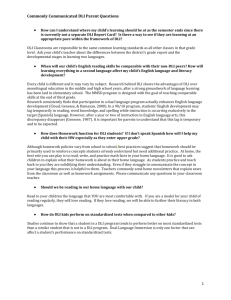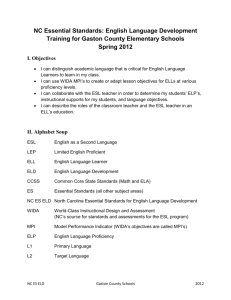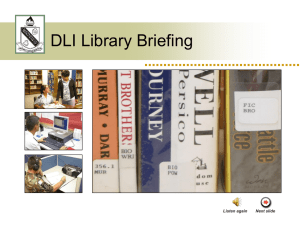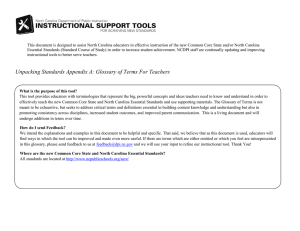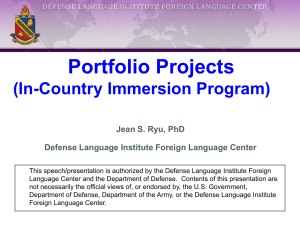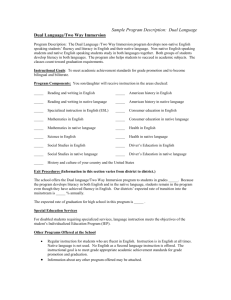The North Carolina Dual Language Story: Ongoing Research Findings 2015 CCSA Conference
advertisement
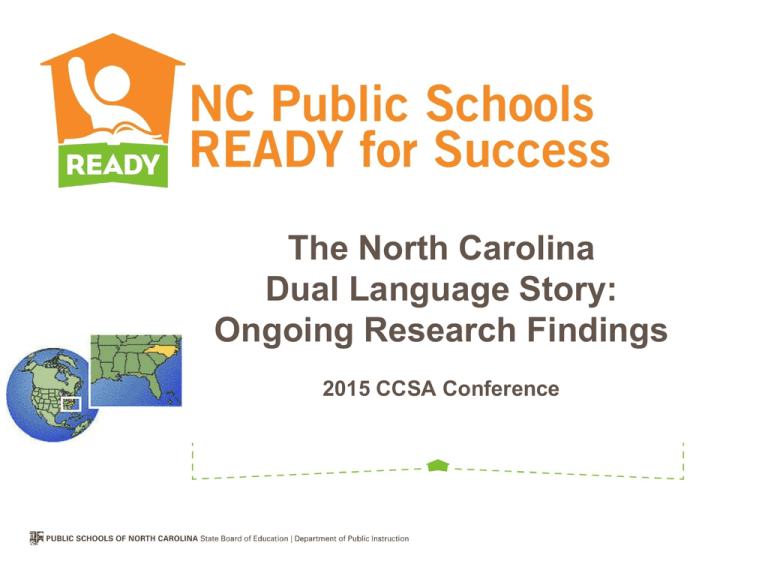
The North Carolina Dual Language Story: Ongoing Research Findings 2015 CCSA Conference Today’s Agenda • History of DLI in North Carolina • DLI Language Proficiency Outcomes in World Language Essential and English Language Development Standards • DLI Program Impact on Closing the Achievement Gap for ALL Students (Statewide Test Results from 2009) History: Before 2005 Basic Education Program (1985) – FLES for ≈ 60% of NC students – Dual Language/Immersion (DLI) programs in 4 districts Accountability and ABCs (mid 1990’s) – FLES for < 20% of NC students – Interest in DLI programs remains steady History: 2005 • Dual Language Conference in January • 7 dual language/immersion programs • Result: Infrastructure needed • Solution: FLAP grant Foreign Language Assistance Program (FLAP) Grant • Goal 1: K-5 Dual Language Standards • Goal 2: Teacher Training • Goal 3: Teacher Licensure Dual Language/Immersion Program Models* ONE-WAY IMMERSION (FULL & PARTIAL) SERVES STUDENTS WHO ARE: GOAL INCLUDES HIGH LEVELS OF PROFICENCY IN: TYPE OF BILINGUALISM: DEVELOPMENTAL BILINGUAL EDUCATION TWO-WAY IMMERSION NATIVE ENGLISH SPEAKERS NATIVE TARGET LANGUAGE** SPEAKERS NATIVE ENGLISH & NATIVE TARGET LANGUAGE** SPEAKERS (Backgrounds) TARGET LANGUAGE** & ENGLISH TARGET LANGUAGE** & ENGLISH TARGET LANGUAGE** & ENGLISH ADDITIVE ADDITIVE ADDITIVE * DLI Program Models describe the students served. **Target Language refers to the language other than English being used for academic content instruction. Note: For students designated as Limited English Proficient (LEP), both the Language Instruction Educational Program (LIEP) plan and the WIDA English Language Development Standards are applicable. The DLI program itself does not supplant the LIEP services provided to English Language Learners (ELLs). NC Dual Language Conference April 22-23, 2008, in Charlotte Collaboration with NCIW initiative Aimed at administrators Novice and veteran strands North Carolina ACRE NC’s Accountability and Curriculum Reform Effort (ACRE) was the state’s comprehensive initiative to redefine: – entire K-12 North Carolina Standard Course of Study (SCS) – student testing program – school accountability model North Carolina State Board Of Education Every public school student will graduate ready for post secondary education and work, prepared to be a globally engaged and productive citizen. Standard Course of Study (SCS) Common Core State Standards North Carolina Essential Standards English Language Arts Arts Education * Literacy Standards for *English Language Development History/Social Studies, Science, *Guidance and Technical Subjects Healthful Living Mathematics *Information and Technology Science Social Studies World Languages * Common Core Literacy Standards, English Language Development, Guidance, and Information & Technology Essential Standards are delivered through ALL content areas. ELD & State Standards ELD Standards State Content Standards Academic language development Academic achievement Language-based Content-based Reflective of the varying stages of second language acquisition Reflective of conceptual development Representative of social and academic language contexts Representative of the school’s academic curriculum WIDA Consortium Intro to WIDA ELD Standards 11 North Carolina World Language Essential Standards K-12 Classical Languages Ancient Greek, Latin, etc., along with classical studies Statewide implementation began Fall 2012 K-12 Dual & Heritage Languages K-12 Modern Languages Dual Language/ Immersion Programs Alphabetic Heritage Language Courses I-II Logographic Visual North Carolina English Language Development Standards WIDA’s ELD Standards Social & Instructional Language Language of Language Arts Language of Mathematics Language of Science Language of Social Studies Academic Language Standard 1 WIDA Consortium Standard 2 Standard 3 Standard 4 Standard 5 Intro to WIDA ELD Standards 14 WIDA Performance Definitions – Listening and Reading Grades K-12 WIDA Performance Definitions – Speaking and Writing Grades K-12 Dual Language/Immersion Program Models* ONE-WAY IMMERSION (FULL & PARTIAL) SERVES STUDENTS WHO ARE: GOAL INCLUDES HIGH LEVELS OF PROFICENCY IN: TYPE OF BILINGUALISM: DEVELOPMENTAL BILINGUAL EDUCATION TWO-WAY IMMERSION NATIVE ENGLISH SPEAKERS NATIVE TARGET LANGUAGE** SPEAKERS NATIVE ENGLISH & NATIVE TARGET LANGUAGE** SPEAKERS (Backgrounds) TARGET LANGUAGE** & ENGLISH TARGET LANGUAGE** & ENGLISH TARGET LANGUAGE** & ENGLISH ADDITIVE ADDITIVE ADDITIVE * DLI Program Models describe the students served. **Target Language refers to the language other than English being used for academic content instruction. Note: For students designated as Limited English Proficient (LEP), both the Language Instruction Educational Program (LIEP) plan and the WIDA English Language Development Standards are applicable. The DLI program itself does not supplant the LIEP services provided to English Language Learners (ELLs). Variations of Language Adapted from Zwiers (2008) WIDA Consortium Intro to WIDA ELD Standards 21 Genre/ Text Type Register Participants’ identities & social roles WIDA Consortium Topic Sociocultural Context Task/ Situation Intro to WIDA ELD Standards 22 Proficiency Outcome Expectations for Dual Language Immersion Programs ACTFL Proficiency Levels Superior-Distinguished-Native Advanced – Paragraph Level Narrate and describe in past, present and future and deal effectively with an unanticipated complication Advanced Intermediate Novice Intermediate – Sentence Level Create with language, initiate, maintain and bring to a close simple conversations by asking and responding to simple questions Novice – Word Level Communicate minimally with formulaic and rote utterances, lists and phrases Language Proficiency Self-Assessment Grid Activity: Expectations by Language Type 1. Study the Proficiency Outcome Expectations charts 2. Note the similarities and differences between alphabetic and logographic languages 3. Be ready to share 1 finding and the reason(s) behind it ACTFL Proficiency Levels Advanced (Storyteller) Intermediate (Survivor) Novice (Parrot) Proficiency Expectations Dual & Heritage Languages: DLI Alphabetic Languages Interpersonal Novice Intermediate End of 2nd grade Advanced End of 12th grade End of 5th grade (Low – Mid sublevels) Interpretive End of 2nd grade End of 12th grade End of 8th grade Presentational End of 2nd (Mid – High sublevels) grade End of 12th grade Proficiency Expectations Dual & Heritage Languages: DLI Logographic Languages Novice Intermediate Advanced Interpersonal End of 2nd grade End of 5th grade (IL-IM) End of 8th grade (IM-IH) End of 12th grade Interpretive Listening End of 2nd grade End of 5th grade (IL-IM) End of 8th grade (IM-IH) End of 12th grade (AL-AM) Interpretive Reading End of 2nd grade(NM) End of 5th grade (NH-IL) End of 12th grade(IH-AL) End of 8th grade (IL-IM) Presentational Speaking End of 2nd grade Presentational Writing End of 5th grade (IL-IM) End of 8th grade (IM-IH) End of 12th grade (AL-AM) End of 2nd grade(NM) End of 5th grade (NH-IL) End of 12th grade(IH-AL) End of 8th grade (IL-IM) Building Proficiency to be Globally Engaged for Work When does a globally-engaged student develop a level of proficiency to use in the global marketplace? Activity: Globally Competitive DLI Students 1. Examine the 2 columns on the right side of the handout 2. Place DLI programs in the last column based on outcomes 3. How would you share this information with 1 group: – School administrators – Local school board – Parent group Thomas and Collier Study • Title III requirement to implement research based practices and programs • Longitudinal Study – 2008 through 2014 – Two-Way Immersion Programs – Focus on English Language Learners (ELLs) – Disaggregate data for other student subgroups Thomas & Collier Study NC LEAs Charlotte/Mecklenburg County Schools Chapel Hill/Carrboro City Schools Chatham County Schools Durham Public Schools Greene County Schools Johnston County Schools Winston-Salem/Forsyth County Schools Thomas & Collier Study Chapter Five: Astounding Effectiveness – The North Carolina Story • Background • Implementation practices • Results from 2008 & 2009 analyses ISBN: 978-0-9843169-1-5 Race/Ethnicity of Students in DL Programs vs. Not in DL Watch for the RED English Language Learners 2009 EOG Results Reading Math White Students 2009 EOG Results Reading Math African American Students 2009 EOG Results Reading Math Low SES Students 2009 EOG Results Reading Math Thomas & Collier Study Next Steps . . . • 2010 Data Analyses available soon • 7-year longitudinal study • Establish protocol and procedures for NCDPI to apply study analyses in future years • Expand protocol to include other DLI models DLI for North Carolina • Communication – Listservs – Webinars – http://ncdliprograms.ncdpi.wikispaces.net/ • SBE Task Force on Global Education Strategic Plan – DLI Statewide Advisory Group – Targeted Expansion of DLI Programs – Teacher Supply & Professional Development • http://www.ncpublicschools.org/curriculum/globaled/ Questions? NCDPI DLI Team Helga Fasciano Special Assistant for Global Education Helga.Fasciano@dpi.nc.gov Christie Lynch Ebert Section Chief of K-12 Programs Christie.LynchEbert@dpi.nc.gov Ann Marie Gunter World Language Consultant Ann.Gunter@dpi.nc.gov Charlotte “Nadja” Trez Title III/ESL Consultant Nadja.Trez@dpi.nc.gov Ivanna Mann Thrower Anderson Title III/ESL Consultant Ivanna.Thrower@dpi.nc.gov Lindsey Fults Title III/ESL Consultant Lindsey.Fults@dpi.nc.gov Michael Riles Title III Data & Reporting Manager Michael.Riles@dpi.nc.gov
